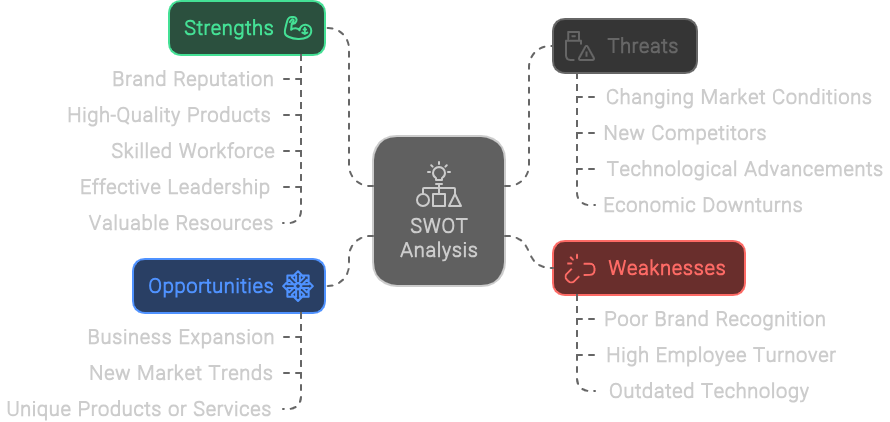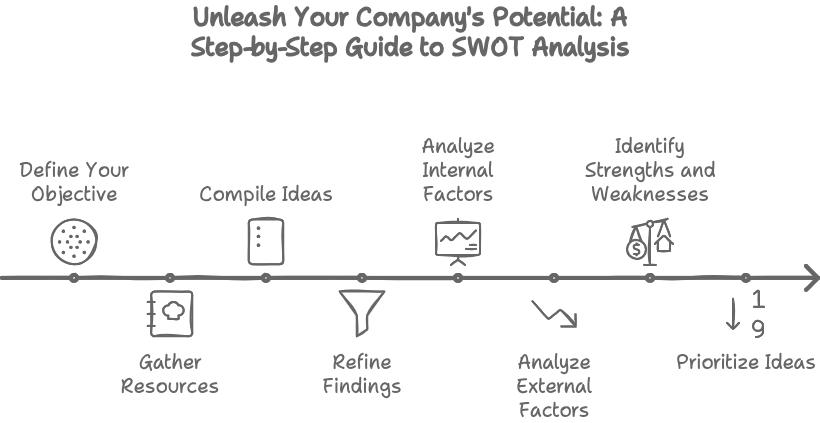SWOT Analysis Budgeting Made Simple
Budgeting can feel overwhelming, but it doesn’t have to be. Using a SWOT analysis, you can break down your budget into four categories: strengths, weaknesses, opportunities, and threats. This helps you understand your financial situation and find areas to improve. Here, we’ll look at how to use SWOT analysis in your budgeting to make reaching your financial goals more accessible.
What’s a SWOT Analysis?
A SWOT analysis is a framework for evaluating a company’s competitive position and developing strategic planning. It helps identify strengths, weaknesses, opportunities, and threats from internal and external sources.
The process involves determining objectives, gathering resources, compiling ideas, refining findings, and developing a strategy based on the ranked list of strengths, weaknesses, opportunities, and threats.
Understanding how to use a SWOT analysis to develop budget priorities can guide decisions in budget planning. It provides realistic, data-driven insights for strategic planning.
Considering internal and external factors is crucial because strengths and weaknesses are internal, and opportunities and threats are external. This provides a comprehensive understanding of the company’s position relative to its competitors and the wider industry, allowing for more effective strategic decision-making.
Understanding the Pieces of SWOT

The Good Stuff: Strengths
Strengths can significantly impact an individual or organization’s success. These strengths might include a strong brand reputation, high-quality products, a skilled workforce, effective leadership, or access to valuable resources. For instance, a reputable brand can enhance customer loyalty and competitive advantage. Similarly, a skilled workforce can boost productivity and innovation, leading to success. Many companies use their brand reputation to attract customers and maintain market share.
Likewise, a talented workforce often drives the development of innovative products and services. Identifying and prioritizing these strengths in budgeting can lay a strong foundation for achieving strategic goals and long-term success.
The Oopsies: Weaknesses
Weaknesses in a SWOT analysis can differ by industry. For example, they could include poor brand recognition, high employee turnover, or outdated technology. Once identified, weaknesses can be addressed through strategic planning and investment.
For instance, if a company identifies employee turnover as a weakness, it can allocate budget resources toward employee retention programs or training initiatives to mitigate the impact of this weakness. Investing in marketing efforts to improve brand recognition can also help address this weakness.
Understanding how weaknesses can be addressed enables companies to develop a more effective budgeting strategy and allocate resources where needed to improve overall organizational performance.
Cool Chances: Opportunities
Opportunities found through a SWOT analysis can include business expansion, new market trends, and the development of unique products or services.
To make the most of these opportunities, individuals or organizations can combine their strengths with the external opportunities identified. This helps them leverage their resources to their advantage.
Not taking advantage of these opportunities can lead to missed chances for growth, innovation, or market presence. This could result in stagnation or falling behind competitors.
Capturing these opportunities is vital for maintaining a competitive edge and driving sustainable business success.
Watch Out for: Threats
Potential threats to consider in a SWOT analysis:
- Changing market conditions
- New competitors entering the market
- Technological advancements
- Economic downturns
These threats can impact a business or organization by forcing it to adapt quickly, reallocate resources, or pivot its business model.
Identifying these threats allows steps to be taken to mitigate or address them. For example:
- Invest in research and development for technological advancements
- Anticipate market trends and adjust product offerings
- Diversify customer base to reduce the impact of economic downturns
Identifying and addressing potential threats helps businesses proactively handle challenges and reduce the impact on strategic planning and budgeting.
Making Your Own SWOT Chart
A SWOT analysis is used to develop a company strategy. It involves identifying a business’s strengths, weaknesses, opportunities, and threats. This helps in understanding the internal and external factors affecting the industry.
Entrepreneurs gather realistic, data-driven insights on current and future potential to create a SWOT chart. They do this by compiling financial data, market trends, and consumer behavior to gather the necessary information.
Once the information is gathered, the entrepreneur can develop and prioritize ideas based on the ranked list of strengths, weaknesses, opportunities, and threats. This guides short-term and long-term budget planning by identifying distinct spending priorities with strategic impacts in mind.
A fictitious organic smoothie company effectively used a SWOT analysis in its strategic planning. It leveraged strengths and external opportunities while addressing weaknesses and eliminating threats.
Getting Your SWOT On: How To Start

What Do You Want to Do?
A SWOT analysis helps a company identify and prioritize factors that can impact strategic planning and budgeting.
It evaluates strengths, weaknesses, opportunities, and threats to understand its competitive position.
For example, a company can use the insights to capitalize on strengths, address weaknesses, and mitigate potential threats for financial stability.
The SWOT chart helps prioritize spending to align with the company’s strengths and strategic initiatives.
Find the Stuff You Need
A SWOT analysis helps entrepreneurs develop company strategy by identifying strengths, weaknesses, opportunities, and threats.
Entrepreneurs can gather financial data, assess customer feedback, and conduct market research to conduct a SWOT analysis.
Prioritizing ideas and findings from the analysis involves ranking the strengths, weaknesses, opportunities, and threats based on their impact on the organization.
This guides the development of a strategic plan for success, focusing on high-impact strengths and opportunities and addressing weaknesses and threats to strengthen the company’s competitive position.
Throw Ideas In The Pot
During a SWOT analysis, different methods can be used to gather ideas. These include brainstorming sessions, employee surveys, and competitor research, which help gather various perspectives and insights.
Anonymous idea submission platforms can be used to ensure all ideas are considered equally. Clear evaluation criteria should be established, and open discussion should be encouraged to prevent bias. These methods help evaluate and prioritize merit-based ideas, leading to a more inclusive and effective SWOT analysis.
Make Your Ideas Shiny
A SWOT analysis can be a helpful tool for identifying an idea’s strengths, weaknesses, opportunities, and threats. It can guide entrepreneurs in setting objectives, gathering resources, compiling ideas, refining findings, and developing a strategy based on the ranked list of these factors.
The resulting SWOT chart visually represents internal and external influences on the idea. It can help prioritize spending that aligns with the strengths and opportunities identified, guiding the budget planning process.
Using a SWOT analysis to determine budget priorities, entrepreneurs can strategically allocate resources and increase the likelihood of their ideas’ success. For example, a fictitious organic smoothie company used a SWOT analysis to leverage strengths and external opportunities, address weaknesses, and eliminate threats, leading to the success of their new product ideas.
Plan How To Win
The process for conducting a SWOT analysis involves several steps.
- Determine the objective.
- Gather resources.
- Compile ideas.
- Refine findings.
- Develop the strategy based on the ranked list of strengths, weaknesses, opportunities, and threats.
To identify strengths and weaknesses, assess internal factors, and analyze where the company excels and areas for improvement.
Evaluating external factors such as market trends, competition, and potential risks can identify and address opportunities and threats.
By understanding external opportunities and threats, a company can leverage its strengths and address its weaknesses.
This process allows for strategic planning and decision-making based on realistic, data-driven insights.
A practical example is The Coca-Cola Company, where the analysis prompted tough questions about its strategy and ultimately proved effective.
Why SWOT’s Super Cool

SWOT analysis is a helpful tool for business and strategic planning. It assesses a company’s strengths, weaknesses, opportunities, and threats. This deeply explains the internal and external factors impacting a business. It allows for informed decision-making and the development of effective strategies.
SWOT analysis helps organizations identify and leverage their strengths. It highlights their competitive advantages and areas of excellence and allows them to address weaknesses and potential threats. This comprehensive assessment enables companies to develop actionable plans. They can maximize strengths while minimizing weaknesses and threats, enhancing their competitive positioning in the market.
SWOT analysis facilitates brainstorming and decision-making processes. Businesses can brainstorm strategies by encouraging a thorough evaluation of a company’s current and potential standing. They can capitalize on strengths and opportunities while addressing weaknesses and threats. This process also helps in goal-setting and staying competitive in the market. It guides the development of focused and relevant strategies based on the company’s unique position and circumstances.
Peek at a SWOT in Action

A SWOT analysis can help a company identify its strengths and weaknesses. It looks at both internal and external factors impacting its competitive position. A company can recognize its strengths by analyzing resources, talent, and capabilities. It can also identify areas for improvement by evaluating internal processes and potential vulnerabilities.
A SWOT analysis can also reveal opportunities and threats. External factors like market conditions, competition, or regulations can be thoroughly evaluated. This helps the company prepare strategies to leverage opportunities and handle potential threats.
A SWOT analysis can influence a company’s strategic plan in many ways. It can inform future objectives, prioritize efforts based on strengths, address areas of improvement, and allocate resources for external opportunities. It can also assist in formulating strategies to minimize the impact of threats.

Vizologi is a revolutionary AI-generated business strategy tool that offers its users access to advanced features to create and refine start-up ideas quickly.
It generates limitless business ideas, gains insights on markets and competitors, and automates business plan creation.


